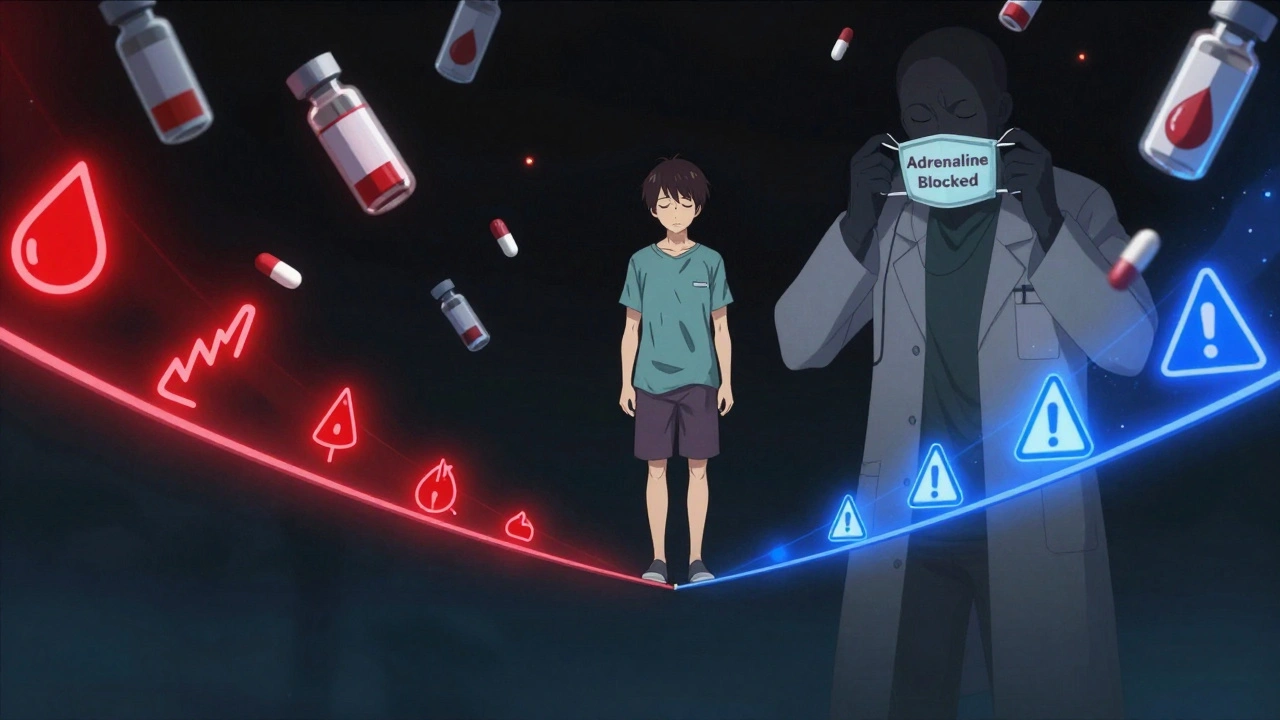Nexium: Uses, Side Effects, and What You Need to Know About Acid Reflux Relief

When your stomach starts burning a hole through your comfort zone and you’re desperately Googling something that’ll let you eat pizza again, chances are you’ll come across Nexium. It’s sitting on the counter of every pharmacy, splashed across TV ads, and probably in your cousin’s medicine cabinet. With acid reflux turning every meal into a gamble, Nexium has built itself up as the go-to fix. But what’s actually going on inside that little purple pill, and is it really the no-nonsense game changer it claims to be?
How Nexium Fights Acid Reflux and Heartburn
If you’ve ever woken up in the night with your throat on fire or had that familiar chest pain after a big meal, you know how miserable heartburn and reflux can be. Nexium’s main job is to dial down that stomach acid that’s splashing into places it shouldn’t. The secret weapon here is a compound called esomeprazole. It’s in a family called proton pump inhibitors (PPIs), which are basically the top dogs for stopping acid production in your gut.
Here’s how it works: There’s a pump in your stomach lining that spits out acid to help break down your food. Nexium blocks a step in that process, so the acid factory slows way down. Less acid means less burn, fewer nights spent propped up with pillows, and you finally get to eat that slice of leftover lasagna. You don’t just pop a Nexium and immediately feel better, though. These pills take a few days to show their full power, so it’s about the long game more than instant relief.
Doctors hand out Nexium for more than just the classic acid reflux, officially called GERD (gastroesophageal reflux disease). It’s also used for ulcers, healing damage to your esophagus from stomach acid, and to keep things chill for folks taking NSAIDs like ibuprofen, which can be rough on your gut. There’s even a version for kids as young as one year old with reflux problems—that’s how much faith the medical world puts in these things. The catch? Nexium’s not a magic bullet. The symptoms might go away, but if you chow down on spicy tacos for breakfast every day, you’re not doing yourself any favors.
Wondering if you can get it without a prescription? In most countries, there’s an over-the-counter Nexium (usually 20mg) but the bigger doses and longer treatments need a doctor’s signature. People sometimes think OTC means totally safe, but prolonged use can still bring trouble—like all medications, there’s a balance to strike between getting relief and not overdoing it. Stick around for some tips on that coming up.
Surprising Side Effects and What to Watch Out For
Scroll through any review site and you’ll see a whole spectrum: people swearing by Nexium, people swearing at it, and a bunch in between. Most folks tolerate esomeprazole just fine; headaches or belly discomfort are the usual suspects. But taking Nexium every day, especially for months or years, isn’t as risk-free as some advertisements make it sound.
Here’s some real talk—the most common side effects are headaches, diarrhea, nausea, and stomach pain. Nothing most adults can’t handle for a little acid relief. But there are some low-key weird things that can show up if you’re using it constantly. For one, because you’re messing with your stomach’s acid levels, Nexium makes it easier for certain bacteria (like C. diff) to move in, turning a simple trip to the bathroom into a horror show. Your stomach acid is like a bouncer—lower it too much and suddenly anyone can get past the door.
There’s also buzz about how long-term use can leach important nutrients like magnesium and vitamin B12 from your system. Why? The acid you’re suppressing actually helps soak up those vitamins and minerals from food. So if you’re feeling extra tired or getting muscle twinges after long-term Nexium, it’s worth checking your levels. Bone fractures in older people are another watchpoint, because the changes in calcium absorption might make bones a little weaker over time.
Big tip here: don’t panic if you’ve just started taking it for a couple weeks—the issues above are mostly tied to folks on months or years of daily use. But no joke, it’s smart to flag any unusual symptoms for your doctor, especially new gut problems, trouble swallowing, or severe diarrhea. You’re looking for the sweet spot where you get the benefits without stacking up risks for later down the line.
How about drug interactions? Nexium can make some meds less effective, especially drugs for HIV, certain blood thinners like clopidogrel, and anti-fungal pills. Even plain things like iron supplements or some heart medications can clash because of the change in stomach acidity. Don’t play pharmacist yourself—double-check with your doctor or pharmacist whenever you start anything new while on Nexium, especially if you’re juggling multiple pills.
Another detail that catches some people off guard: if you suddenly stop Nexium after months of use, your stomach might double down on acid production for a while. It’s called rebound acid hypersecretion. Talk to your doc if you want to come off it—they might help you taper down instead of going cold turkey.

Tips for Taking Nexium Safely and Getting the Best Results
If you’ve landed on Nexium, either on your own or with your doctor’s help, there are some ways to make the most of it and avoid the downsides. First thing—timing matters. Take Nexium at least an hour before you eat, when your stomach is still empty. Think of it as priming the pump (or, actually, blocking it) before food comes along to trigger acid production. If you forget and eat, don’t double up; just wait for the next dose.
Set yourself up for success by making a few backup moves that’ll support your acid defenses. Lifting the head of your bed a few inches can stop that nighttime burn, and passing up late-night burgers gives your stomach time to settle. You don’t need to overhaul your life, but basic choices—smaller meals, less caffeine and booze, not lighting up cigarettes—make Nexium’s job easier and might mean you can step down your dose sooner.
A massive 2022 study found that some people prescribed PPIs like Nexium could shorten their treatment after a few months with simple diet tweaks. So, pay attention to your body and see if you can gradually drop the medicine instead of taking it forever. Some docs recommend trying every-other-day dosing when things calm down, just to see if you need the full throttle approach all the time.
Don’t split or crush the pills—these are special delayed-release capsules, and mucking with them means the drug won’t work right. There are sachets and a few liquid forms for people who have trouble swallowing pills, but always check the exact instructions. And if you notice any rashes, breathing problems, or swelling, get help quickly—though rare, severe allergic reactions can happen.
One thing a lot of folks don’t realize: antacids like Tums or Gaviscon work super fast but for a shorter time. Nexium is more like a slow-burn fix, gradually keeping acid down for the long haul. There's nothing wrong with a combo, but space them out (about two hours apart) to keep both working their best. This gives you the immediate relief of a chewable and the steady support of Nexium without short-circuiting either one.
If you’re traveling or life gets unpredictable, keep your pills handy in a small container. Missing doses now and then won’t be the end of the world, but try to stay regular for the best effect. For anyone who’s pregnant, nursing, or planning to be—Nexium is sometimes approved, but only if the benefits clearly outweigh risks, so team up with your doctor for this one.
Last thing—don’t forget follow-up. If you started Nexium for serious reasons, like ulcers or Barrett’s esophagus, sticking with check-ups is key. For garden variety heartburn, if you’re taking it for more than a couple months in a row, it’s worth double-checking with your doctor. Sometimes, what feels like heartburn is actually something else, and you don’t want to miss a bigger problem.
Nexium FAQs: Your Burning Questions Answered
People love to swap stories and advice about heartburn meds, but a lot of myths stick around. Here’s what you’ve probably wondered:
- Can Nexium cure reflux for good? Not quite—it controls symptoms and gives your body a break to heal, but if you ditch it and don’t change anything else (like diet or habits), reflux often creeps back. It’s like painting over rust; looks better, but needs maintenance underneath.
- Is prescription Nexium better than the OTC version? They’re basically the same thing in different strengths. Your doctor might choose higher doses for certain conditions, but it’s not a secret recipe you’re missing with the over-the-counter stuff.
- What happens if I take Nexium with food? It won’t be absorbed as well. You’ll get more out of it if you take it before eating, but don't panic if you mess up occasionally.
- Is it safe for kids? For some kids with confirmed reflux, specialists prescribe Nexium. It's not something to give kids without a doctor's input because reflux in children can mean something different than in adults.
- Can I drink alcohol with Nexium? Alcohol itself can trigger reflux, so it's not a direct medicine interaction, but it might undo the work Nexium's doing. Moderation and timing help.
The bottom line for most people is that Nexium is pretty effective when taken right and checked in with your doc every so often. Always keep an eye on how you feel and don’t let heartburn take over your life. There’s always an option—whether that’s medicine, lifestyle tweaks, or getting a fresh perspective from your healthcare provider.






Comments
kenneth strachan
July 18, 2025 AT 11:13Alright, so everyone swears by Nexium like it's some miracle cure, but let's get real for a second. It does work, yeah, it reduces acid, but you gotta watch out for the rebound acid production when you stop taking it. Like suddenly your stomach's overcompensating and you get even worse symptoms.
Plus, I heard livelong use can mess with your magnesium levels or even lead to kidney problems. Seems a bit dramatic, but docs do warn about that. Has anyone here experienced this? Like, how careful should we be?
I'm all for safe usage, but it feels like they just hand these meds out like candy nowadays. Would love to hear more detail about the risks and if natural remedies are worth a shot instead.
Adele Joablife
July 19, 2025 AT 06:40I totally get your skepticism. It’s refreshing to see someone actually question the overprescription culture we’re stuck in. I've been on Nexium for a few months myself, and yes, the side effects warnings are everywhere, but the relief it offers is undeniable.
That said, I think people don’t take the lifestyle adjustments seriously enough—diet changes, avoiding triggers, timing meals better. The medication should be more like an aid, not your go-to unless absolutely necessary.
Also, magnesium depletion is real. I’ve supplemented since I started the drug. It's a balance, and I think patients need to educate themselves rather than blindly trusting the convenience of pills.
Mandy Mehalko
July 19, 2025 AT 20:33Hey, just popping in to share a positive note! I was super skeptical about Nexium too, but it really turned my daily heartburn misery into manageable symptoms. I even cut back on my other meds thanks to it.
I guess everyone's body reacts differently. For me, it's been smooth sailing without any scary side effects. I just follow my doctor’s dosage instructions strictly and try to eat healthier.
Honestly, balancing meds with lifestyle changes has been the key for me. I encourage others to keep an open mind and work closely with their healthcare provider.
Patrick Vande Ven
July 20, 2025 AT 16:00From a pharmacological standpoint, Nexium—esomeprazole—is a potent proton pump inhibitor, very effective at preventing gastric acid secretion. It’s crucial, however, to recognize its mechanism in context with its side effect profile.
Long-term usage has been associated with increased risks of osteoporosis-related fractures, as well as nutrient malabsorption, notably vitamin B12 and magnesium deficiencies. Monitoring and medical supervision should be mandatory for patients on extended courses.
Furthermore, patient education on discontinuation symptoms, such as acid rebound, is essential to avoid unnecessary panic or symptom exacerbation.
Thomas Burke
July 21, 2025 AT 01:43Interesting stuff here. I was wondering, with how common Nexium has become, are there any known interactions with other commonly used medications? Like some OTC or supplements anyone should be careful about?
Also, I’d like to know if it’s appropriate for all ages, especially elderly folks who might have multiple prescriptions already. Is the risk higher for them?
It’s great to understand the benefits, but knowing the limits and cautions seems equally important.
Gerard Parker
July 21, 2025 AT 19:46Addressing some of these concerns with authority here — yes, Nexium does interact with certain meds, especially those requiring acidic environments for absorption, such as ketoconazole or some HIV drugs.
Elderly patients do need more cautious dosing given their general vulnerability to side effects like bone density loss and impaired kidney function. The healthcare provider must carefully weigh benefits versus risks in these demographics.
Regarding supplements, magnesium is often depleted after long-term PPI use; therefore, supplementation is sometimes necessary. But otherwise, caution is advised with drugs like clopidogrel.
In sum, always consult your physician before mixing anything.
Peter Jones
July 22, 2025 AT 15:13Thanks for all this insightful discussion! I'm trying to be open-minded in understanding both the benefits and drawbacks of meds like Nexium.
Has anyone here tried combining Nexium with dietary strategies such as low acid diets or intermittent fasting? I wonder if that lessens dependence on medication over time.
Sometimes it feels like the medical culture is too quick to medicate instead of empowering patients with holistic approaches.
Bryan Kopp
July 22, 2025 AT 19:23Can’t believe how much attention this little pink pill gets! I’m all about taking care of yourself, but if people just ate less junk and stopped whining about heartburn, maybe we’d see less need for these meds.
Sure, some have side effects but maybe that’s a small price for relief. No offense but a lot of folks act like popping a pill is some kind of crime.
Anyway, does anyone else feel like the media overhypes the dangers of such drugs?
Heather Jackson
July 22, 2025 AT 23:33Hey y’all, just FYI, in Canada we don’t see Nexium overprescribed nearly as much as in the US, plus generic options exist that work the same and cost way less.
Also, I found vegan-like diets and avoiding late night dinners helped me dramatically alongside my prescribed treatment. The drama around side effects is there, but many are manageable if you pay attention.
Keep asking your doctors, and don’t be shy about adjusting lifestyle first—sometimes that works wonders.
Michelle Abbott
July 24, 2025 AT 11:40Some jargon for the curious: Nexium is a PPI, or proton pump inhibitor, which blocks the proton pumps in your stomach lining to reduce acid production. Pretty neat, huh?
But be warned, prolonged use can cause pharmacokinetic issues including hypomagnesemia and increased risk of Clostridium difficile infection due to reduced stomach acidity.
Fascinating how a simple pill can have such complex systemic effects, would be great if patients and prescribers discussed this thoroughly.
Tim Giles
August 16, 2025 AT 23:33In reading all this, one question is whether Nexium’s efficacy diminishes over prolonged treatment periods due to tachyphylaxis or tolerance development? If anyone has clinical experience or studies on that, it’d be illuminating to share.
Additionally, the socioeconomic aspect of access to such medications globally, and cost-effectiveness in chronic treatment models, is an area I wish was discussed more openly.
Overall, this thread is a good start, but there’s a world of nuances around this drug that warrant deeper examination.
Adele Joablife
August 17, 2025 AT 05:06Really appreciate all the high-level insight here. To add – I did notice with prolonged use my symptoms changed in character, which made me think if the meds were causing shifts in gut flora or gut function. I haven’t seen a lot written about that.
Anyone else experience something similar or have thoughts on gut health during PPI therapy?
It’s such a balancing act, hoping for symptom relief but wary of long-term consequences. This article and thread have helped me think holistically about it.